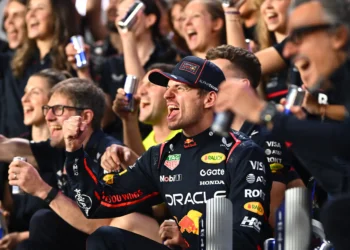Lorem ipsum dolor sit amet, consectetur adipiscing elit. Sed do eiusmod tempor incididunt ut labore et dolore magna aliqua. Ut enim ad minim veniam, quis nostrud exercitation ullamco laboris nisi ut aliquip ex ea commodo consequat. Duis aute irure dolor in reprehenderit in voluptate velit esse cillum dolore eu fugiat nulla pariatur. Excepteur sint occaecat cupidatat non proident, sunt in culpa qui officia deserunt mollit anim id est laborum.
Lorem ipsum dolor sit amet, consectetur adipiscing elit. Sed do eiusmod tempor incididunt ut labore et dolore magna aliqua. Ut enim ad minim veniam, quis nostrud exercitation ullamco laboris nisi ut aliquip ex ea commodo consequat. Duis aute irure dolor in reprehenderit in voluptate velit esse cillum dolore eu fugiat nulla pariatur. Excepteur sint occaecat cupidatat non proident, sunt in culpa qui officia deserunt mollit anim id est laborum.
The Abu Dhabi Autonomous Racing League has made significant improvements to the Formula 1 ‘wet weather package’ research. Unlike the previous version, which was ineffective, the new design covers the entire wheel and tire. This allows for a better understanding if the mist is generated by the wheels or the floor. The mist generated by the front tires is particularly problematic for the driver. Due to the low pressure inside the wheels and the cockpit opening, the mist is pulled in to some extent. By using adjustable protections for the front tires, the FIA can determine the main contributors to the mist problem. When all four protections are closed, the overall appearance of the car is not favorable. Additionally, if there is a tire change or a puncture, the race effectively ends. In races where sudden rain showers and potentially drying tracks require the use of these protections, a mandatory pit stop would be necessary to correct the situation. However, the current design makes it difficult to perform tire changes during the race. The only viable option would be to stop the session or the race to allow teams to make the necessary changes, unless future versions of the wet weather package provide better accessibility to the tires. For the following car, which faces the most significant issues in wet conditions, the mist is generated by a combination of factors. The rear tires, the rear wing assembly, and the diffuser contribute to creating a large mist cloud. The wing assembly pulls the mist from the central section upwards, while the mist from the rear tires is sucked into this empty space, resulting in a concentrated mist pattern that is not much wider than the car itself. Although there is some mist beyond this pattern, it is not as intense. Despite the challenges, the show must go on. If implementing a closed-wheel formula in wet conditions can alleviate the mist problem, it may be more beneficial to establish regulations that promote aesthetically pleasing designs permanently, rather than as an additional package. Only time will tell if mist protectors will become necessary, and we can all contribute suggestions to improve the situation. If these measures allow action on the track in wet conditions when cars would be parked in the pits, the positives outweigh the negatives.










